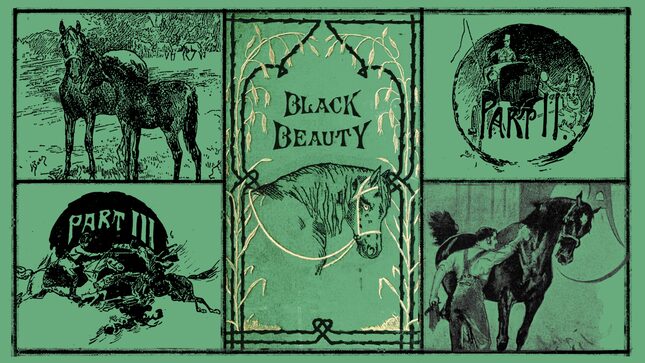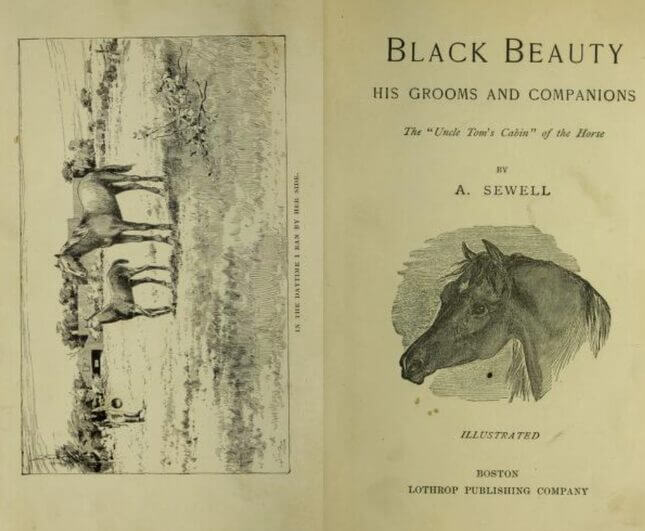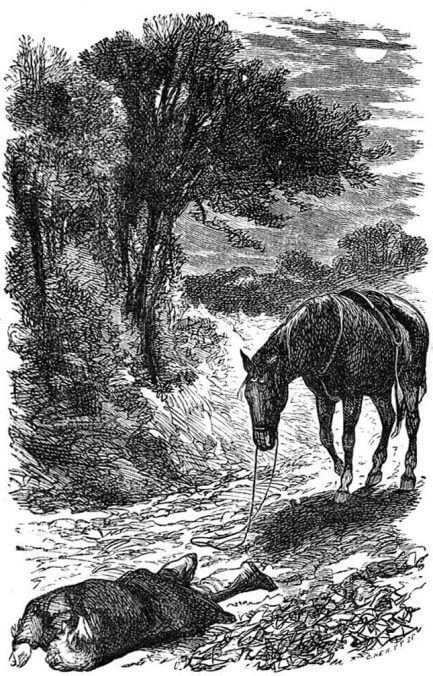
Image: Elena Scotti (Photos: Wikimedia Commons)
Anna Sewell’s Black Beauty (1877) is not often a novel that comes to mind when we think about Victorian literature. There are no youths entangled in agonized romantic longing, nor plucky orphans determined to distinguish themselves in a rapidly industrializing London, nor labyrinthine mysteries surrounding inherited wealth or parentage. No wives are imprisoned in attics (thank goodness), and nobody wears a decades-old, moldering wedding dress to mourn the lover who jilted her at the altar. These are the sorts of stories we tell about people, and Black Beauty is the story of a horse.
Sewell, whose bicentennial is on March 30 of this year, named her first and only novel Black Beauty, his grooms and companions; the autobiography of a horse,‘Translated from the original equine by Anna Sewell’—and as the rather verbose title suggests, the story is narrated in first person, by Black Beauty himself. It chronicles the ebb and flow of his fortunes, from an idyllic colt-hood to a happy, plush situation amongst benevolent rich folks, to the afflictions of hard labor and abuse. “I am writing the life of a horse,” Sewell declared in an 1871 diary entry, explaining that her motivation was to “induce kindness, sympathy, and an understanding treatment of horses.” This decision to write from Beauty’s perspective was a profound exercise in empathy, and while it might seem like an obvious choice to those of us who grew up with Charlotte’s Web and Frog and Toad, Victorian readers were less accustomed to books that featured talking animals. Surely, an animal narrator was even more of a surprise. With rare exceptions, like Francis Coventry’s 1751 novel The History Of Pompey The Little, fiction remained a province of human experience.
Black Beauty’s novelty must have worked in its favor because it was a prodigious success. Jarrod & Sons paid Sewell a meager £20 for the rights to the book; it was published on November 24, 1877; and by 1890, it had sold over 200,000 copies. Sewell, however, never saw her book become a literary juggernaut, nor did she enjoy any financial benefits: in April 1878, she died of hepatitis, shortly after her 58th birthday. Black Beauty had only been on the market for five months; certainly, there was no way to know that her manifesto on animal rights—modest and green, a sketch of horse gazing woefully from its cover—would become one of literary history’s best-selling books. It has never once gone out of print.
Black Beauty is typically categorized as children’s literature, and although Sewell did not write with a young audience in mind—she hoped to reach those who worked directly with horses—the taxonomy makes sense, and it calls to mind the skepticism we so often direct at imagined animal subjectivity. Stories featuring chatty animals tend to be treated as whimsical and fairytale-adjacent; they demand suspension of disbelief in a way that adults are less inclined to indulge. Sometimes my own intolerance on this front feels like a personal limitation, an unwillingness to dwell in the pleasure of fantasy—and, moreover, to extend my empathy to that length. Generally, I prefer my animal-centric media and literature to be winkingly clever: Zootopia instead of, say, Bambi. I am asking for my fragile adult ego to be soothed and validated, for the film or book to insinuate that it knows that I know we are frolicking in impossible fiction. I would rather feel intelligent for understanding the way a trope is manipulated than give myself over to an earnest anthropomorphic narrative that isn’t interested in either meta-jokes or appealing to cynicism.

But regardless of the story’s tone, hyper-articulate animal characters like Black Beauty are an oft-welcome presence in children’s media; after all, fanciful conceits can mitigate the tedium of didacticism. It’s no surprise that children’s literature, particularly from the Victorian and Edwardian periods, veers towards the morally educational. In 19th-century England especially, it was a handy mechanism for breeding loyal, Christian British subjects. And over time, writers like Beatrix Potter (The Tale of Peter Rabbit), A.A. Milne (The House at Pooh Corner), and Arnold Lobel (Frog and Toad) have sought to instruct through gentler, more compassionate means. That said, Potter’s bucolic tales can be singularly harrowing, even disturbing. I’m pretty sure that reading The Tale of Jemima Puddle-Duck as a little girl did more to exacerbate my existential anxiety than to instill good sense.
In recent years, shows for so-called “mature audiences” like Bojack Horseman and Tuca and Bertie have engaged anthropomorphism as a way of sussing out the particular nonsense and tragedy of living in the world. But Tuca and Bertie, which was created by Bojack’s production designer and producer, Lisa Hanawalt, was unceremoniously canceled after only one stellar season, and for the most part, this sort of material remains a rare phenomenon, just as Black Beauty was when it was first published.
Of course, Beauty would not know what to make of Bojack: setting aside the likelihood that he would consider him a strident asshole, Sewell’s protagonist would be baffled by the very fact of him. After all, what horse wears clothes, drinks booze, and seduces humans? Black Beauty is not the tale of an anthropomorphic horse—not exactly, anyway. Here again, we require suspension of disbelief: somehow, Beauty’s memoirs have been translated by Sewell for a Victorian audience, most of who depend on horses, and who, whether through ignorance or lack of empathy, may not care for them as tenderly as they should. The horse cannot advocate for himself without an English-speaking intermediary. He can only communicate fluently with his own kind, and his inclinations are entirely species-appropriate: he enjoys crunching on oats, reposing with a warm blanket draped over his back, and galloping across grassy fields.
Sewell champions his cause. She loved horses, as one might expect, but she also understood her debt to them, and knew that most of her contemporaries shared in it. Horses were ubiquitous in pre-motorized society, and people thoroughly relied upon them, whether for transportation, brute labor, or sport. After an ankle injury led to frequent walking difficulty, Sewell depended on a pony and trap for mobility, a necessity that was, simultaneously, a pleasure. According to novelist Jane Smiley, “She loved to drive the family pony, and she loved to talk to the pony as if the pony could understand her.” Then, it became her object to make humans understand these creatures that were so dear to her, and that were vulnerable—sometimes perilously so—to the caprices of those who possessed them for their own convenience or personal gain.
Had Black Beauty not soared to commercial success, Sewell might have hollered into the void. But instead, her novel’s legacy is a relatively heartening one, entwined with social reform. For instance, Black Beauty is credited with the outlawing of bearing reins, a device Beauty describes in detail so as to illuminate its wanton cruelty. An aristocratic whim, the bearing rein forced a visible arch in a horse’s neck through tremendous muscular strain. The look was all the rage—but as Beauty tells his readers, it was torture for those subjected to it. “What I suffered for four long months with that rein it would be hard to describe,” Beauty narrates, “but I am quite sure that, had it lasted much longer, either my health or my temper would have given way.” This is a basic tenet of the book: a horse’s good disposition cannot be expected to survive ill treatment.
Perhaps Beauty is correct in his perception that he escapes abuse in the nick of time, just before it curdles his mild disposition and renders him surly and volatile, like his friend Ginger. Or perhaps his relative humility, together with his seemingly unflappable nature, are further evidence of Beauty’s good breeding, of which we are reminded intermittently throughout the novel. His mother, Duchess, elaborates upon their shared prizewinning genetics at the start of the novel, in an effort to teach Beauty the importance of good manners:
You have been well bred and well born; your father has a great name in these parts, and your grandfather twice won the Cup at the Newmarket races; your grandmother had the sweetest temper of any horse I ever knew, and I think you have never seen me kick or bite.
Even horses are not entirely exempt from Victorian England’s maniacally stratified class hierarchy. Beauty’s reliability as a narrator is tethered to his robust genealogy and upbringing; we can trust his testimony because he is, by his own account, a Very Good Boy. Nineteenth-century servants, human and otherwise, were valued for their docility, diligence, and loyalty; these were esteemed traits that both benefited their upper-class employers and buttressed their notions of inherent superiority. John Manly, Birtwick Park’s head coachman, or Joe Green, who trains under him, could be interpreted as Beauty’s human counterparts: they are both tremendously capable, but their talents never supersede their deference: like Beauty, they are always willing to obey those they have been taught to serve.

For Beauty, however, gentility and servitude are mutually constitutive. He seems to occupy the horse’s variation of an aristocratic echelon. His narration is frank and clear, and it’s also unmistakably refined. Yet by virtue of his species, everything that distinguishes him—bloodline, breeding, a strikingly handsome appearance—recommends Beauty for a life of labor. Granted, he enjoys advantages denied to less elegant horses, and they swiftly diminish once ill use mars his appearance. After an easily preventable accident leaves him with scarred knees, he is banished from gentlemen’s stables and sold into England’s impoverished workforce. Beauty’s name is foreshadowing enough for this sort of misfortune. It may be a gesture of affection, but it is more tellingly a signifier of his marketability. The happiness and safety of a non-human creature is rarely theirs to determine: Beauty tells this story, but neither he nor his companions are the authors of their own fates. Indeed, the British Library suggests that the novel “has become a children’s literary classic perhaps because it reflects a child’s sense of impotence.” While Sewell imagines an extraordinary horse who can convey his own sense of the world, it’s a fantasy of empowerment that paradoxically illuminates the storyteller’s profound vulnerability.
Beauty’s powerlessness—to protect himself from harm, and to choose the men to whom he is tethered—must have resonated with Victorian women, too. A pretty young woman from a socially secure family might have the opportunity for a comfortable life, but her choices were nonetheless paltry, and marital felicity was a particular gamble. Ginger, the skittish chestnut mare who becomes Beauty’s dearest friend, suffers trauma that both illustrates the psychological impact of barbaric treatment on a horse and suggests an allegorical parallel for the physical and sexual abuse suffered by women. “There was no gentleness in [my old master’s son] as there was in his father,” Ginger recollects to Beauty, “I felt from the first that what he wanted was to wear all the spirit out of me, and just make me into a quiet, humble, obedient piece of horse flesh. ‘Horse-flesh!’ Yes, that is all he thought about.” Her memories, almost erotic in articulation, call to mind The Taming of the Shrew, with even more savagery.
Sewell does not have a light didactic touch—neither in this scene, nor in the rest of the novel—although I suspect that didn’t interest her in the first place. Black Beauty is, after all, as much a manifesto as it is a novel: every horse Beauty encounters shares a personal history that draws out the ways a person may either do good or harm to the creatures they engage. In Ginger’s case, Sewell shows the consequences of recurrent vicious treatment on a horse by rewriting a well-traveled tragedy: the fall of a beautiful woman who is, according to Victorian ideology, gradually “ruined” by her various relationships with men. Of course, unlike human women, Ginger is not stigmatized for her affliction, at least, not when she is in John Manly’s care: her moodiness and violence are identified as the evident result of poor handling, and Beauty presents her as a victim ensnared within a society that does not prioritize the welfare of animals. But as her grim plot makes clear, Ginger’s innocence does her precious little good.
Still, I’ve been reading Black Beauty since I was a little girl, and I can’t seem to stop—nor can, it seems, millions of others. This is heartening: a small, but palpable indication, in the midst of so much chaotic, global sorrow, that we know what we owe to those who cannot always advocate for themselves. We know what we owe—but as Anna Sewell might remind us, we must also be willing to give it.
Rachel Vorona Cote is the author of Too Much: How Victorian Constraints Still Bind Women Today, which was published in February 2020 by Grand Central Publishing. She also publishes frequently in such outlets as Longreads, The New Republic, Literary Hub, Pitchfork, Hazlitt, and Catapult and was previously a contributing writer at Jezebel. She lives in Takoma Park, MD.